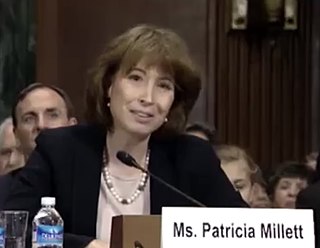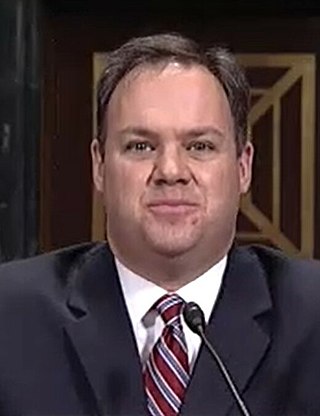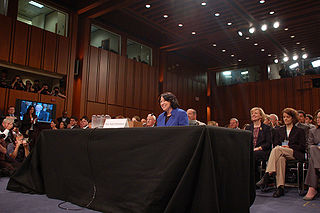
The Supreme Court of the United States is the highest-ranking judicial body in the United States. Established by Article III of the Constitution, the detailed structure of the court was laid down by the 1st United States Congress in 1789. Congress specified the Court's original and appellate jurisdiction, created 13 judicial districts, and fixed the initial size of the Supreme Court. The number of justices on the Supreme Court changed six times before settling at the present total of nine in 1869. A total of 115 justices have served on the Supreme Court since 1789. Justices have life tenure, and so they serve until they die in office, resign or retire, or are impeached and removed from office.

Speculation abounded over potential nominations to the Supreme Court of the United States by President George W. Bush since before his presidency.
In the United States Senate, the nuclear option is a parliamentary procedure that allows the Senate to override a standing rule by a simple majority, avoiding the two-thirds supermajority normally required to invoke cloture on a resolution to amend Senate rules.
The Gang of 14 was a bipartisan group of Senators in the 109th United States Congress who successfully, at the time, negotiated a compromise in the spring of 2005 to avoid the deployment of the so-called "nuclear option" by Senate Republican Majority over an organized use of the filibuster by Senate Democrats. The term alludes to the phrase "Gang of Four", used in China to refer to four ex-leaders blamed for the abuses during the rule of Mao Zedong.

Patricia Ann Millett is a United States circuit judge of the United States Court of Appeals for the District of Columbia Circuit. She formerly headed the Supreme Court practice at the law firm Akin Gump Strauss Hauer & Feld. Millett also was a longtime former assistant to the United States Solicitor General and served as an occasional blogger for SCOTUSblog. At the time of her confirmation to the D.C. Circuit, she had argued 32 cases before the United States Supreme Court. In February 2016 The New York Times identified her as a potential nominee to replace Justice Antonin Scalia.

The nomination and confirmation of justices to the Supreme Court of the United States involves several steps, the framework for which is set forth in the United States Constitution. Specifically, Article II, Section 2, Clause 2, provides that the president of the United States nominates a justice and that the United States Senate provides advice and consent before the person is formally appointed to the Court. It also empowers a president to temporarily, under certain circumstances, fill a Supreme Court vacancy by means of a recess appointment. The Constitution does not set any qualifications for service as a justice, thus the president may nominate any individual to serve on the Court.

Lucy Haeran Koh is an American lawyer and jurist serving as a U.S. circuit judge of the U.S. Court of Appeals for the Ninth Circuit. She is the first Korean American woman to serve on a federal appellate court in the United States. Koh previously served as a U.S. district judge of the U.S. District Court for the Northern District of California from 2010 to 2021. She also served as a California state court judge of the Santa Clara County Superior Court from 2008 to 2010.
A filibuster is a tactic used in the U.S. Senate to delay or block a vote on a measure by preventing debate on it from ending. The Senate's rules place few restrictions on debate; in general, if no other senator is speaking, a senator who seeks recognition is entitled to speak for as long as they wish. Only when debate concludes can the measure be put to a vote. Rule XXII of the Standing Rules of the Senate allows the Senate to vote to limit debate by invoking cloture on the pending question. In most cases, however, this requires a majority of three-fifths of senators duly chosen and sworn, so a minority of senators can block a measure, even if it has the support of a simple majority.
U.S. President Barack Obama nominated over 400 individuals for federal judgeships during his presidency. Of these nominations, Congress confirmed 329 judgeships, 173 during the 111th & 112th Congresses and 156 during the 113th and 114th Congresses.

Gregg Jeffrey Costa is an American attorney who is a former United States circuit judge of the United States Court of Appeals for the Fifth Circuit and former United States district judge of the United States District Court for the Southern District of Texas.

Joan Louise Larsen is an American attorney serving as a United States circuit judge of the United States Court of Appeals for the Sixth Circuit. She previously was an associate justice of the Michigan Supreme Court from 2015 to 2017.
Donald Trump, President of the United States from 2017 to 2021, entered office with a significant number of judicial vacancies, including a Supreme Court vacancy due to the death of Antonin Scalia in February 2016. During the first eight months of his presidency, he nominated approximately 50 judges, a significantly higher number than any other recent president had made by that point in his presidency. By June 24, 2020, 200 of his Article III nominees had been confirmed by the United States Senate. According to multiple media outlets, Trump significantly impacted the composition of the Supreme Court and lower courts during his tenure.

On September 26, 2020, President Donald Trump announced the nomination of Amy Coney Barrett to the position of Associate Justice of the Supreme Court of the United States to fill in the vacancy left by the death of Ruth Bader Ginsburg. At the time of her nomination, Barrett was a Judge of the United States Court of Appeals for the Seventh Circuit in Chicago, Illinois. The Senate received word from the president on September 29.
President Joe Biden began his presidency with fewer vacancies to fill than his predecessor. President Biden pledged to nominate people with diverse backgrounds and professional experience. Biden also pledged to nominate the first Black woman to the Supreme Court of the United States.

Harlan F. Stone was nominated and confirmed twice to the Supreme Court of the United States. First in 1925, when President Calvin Coolidge nominated him to serve as an associate justice and again in 1941, when President Franklin D. Roosevelt nominated Justice Stone to be elevated to Chief Justice. Both times, the United States Senate confirmed the nominations.

Thurgood Marshall was nominated to serve as an associate justice of the Supreme Court of the United States by U.S. President Lyndon B. Johnson on June 13, 1967 to fill the seat being vacated by Tom C. Clark. Per the Constitution of the United States, the nomination was subject to the advice and consent of the United States Senate, which holds the determinant power to confirm or reject nominations to the U.S. Supreme Court. Marshall was confirmed by the U.S. Senate in a 69–11 vote on August 30, 1967, becoming the first African American member of the Court, and the court's first non-white justice.

Since the creation of the Senate Committee on the Judiciary in 1816, many, but not all, nominations for the Supreme Court of the United States have been first referred to a committee for review prior to facing a confirmation vote before the full United States Senate. Some nominations have been withdrawn, lapsed, or been postponed without being referred to the Judiciary Committee, while some others up until 1941 had proceeded to full Senate confirmation votes without first being reviewed by the Judiciary Committee. However, ever since 1941, all nominations have been referred to the Judiciary Committee.











